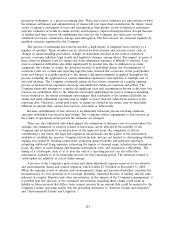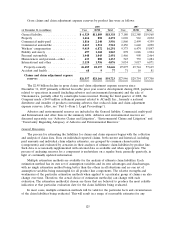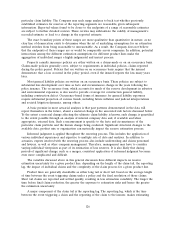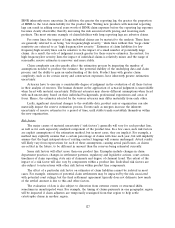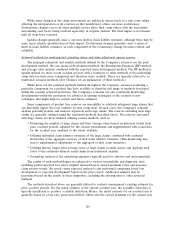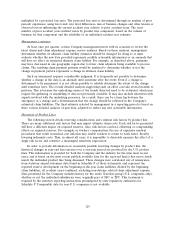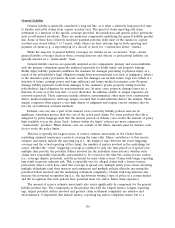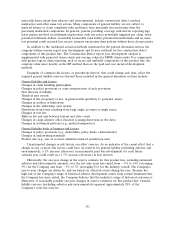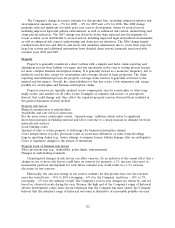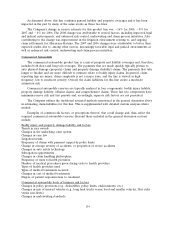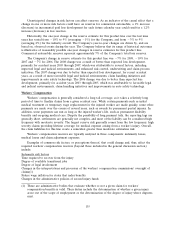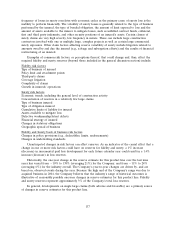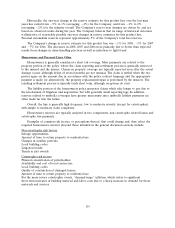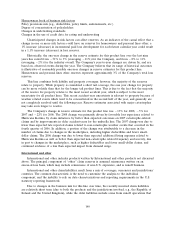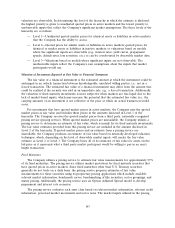Travelers 2008 Annual Report Download - page 145
Download and view the complete annual report
Please find page 145 of the 2008 Travelers annual report below. You can navigate through the pages in the report by either clicking on the pages listed below, or by using the keyword search tool below to find specific information within the annual report.
changes in reserve estimates for this product line. Property reserves represent approximately 4% of the
Company’s total loss reserves.
While property is considered a short tail coverage, the one year change for property can be more
volatile than that for the longer tail product lines. This is due to the fact that the majority of the
reserve for property relates to the most recent accident year, which is subject to the most uncertainty
for all product lines. This recent accident year uncertainty is relevant to property because of weather
related events which tend to be concentrated in the second half of the year, and generally are not
completely resolved until the following year. Reserve estimates associated with major catastrophes may
take even longer to resolve. The reserve estimates for this product line are also potentially subject to
material changes due to uncertainty in measuring ultimate losses for unprecedented significant
catastrophes such as the events of September 11, 2001 and Hurricane Katrina.
The Company’s change in reserve estimate for this product line was 22% for 2008, 18% for
2007 and 11% for 2006. The 2008 change was primarily driven by favorable development in the 2007
accident year for certain large property, ocean marine and inland marine claim exposures, and
improvements in the litigation environment relating to, and ongoing claim settlements for, Hurricane
Katrina. The 2007 change was due to fewer than expected late reported claims related to
non-catastrophe weather events that occurred late in 2006 as well as better than expected frequency
and severity due in part to changes in the marketplace, such as higher deductibles and lower policy
limits. In addition, the property product line experienced better than expected large loss outcomes
which were partially attributable to favorable litigation resolutions. The 2006 change primarily reflected
less ‘‘demand surge’’ inflation than originally estimated for 2005 accident year non-catastrophe and
catastrophe losses.
Commercial Multi-Peril
Commercial multi-peril provides a combination of property and liability coverage typically for small
businesses and, therefore, includes both short and long tail coverages. For property coverage, it
generally takes a relatively short period of time to close claims, while for the other coverages, generally
for the liability coverages, it takes a longer period of time to close claims.
The reserving risk for this line is dominated by the liability coverage portion of this product, except
occasionally in the event of catastrophic or large single losses. The reserving risk for this line differs
from that of the general liability product line and the property product line due to the nature of the
customer. Commercial multi-peril is generally sold to smaller-sized accounts, while the customer profile
for general liability and property includes larger customers.
See ‘‘Property risk factors’’ and ‘‘General liability risk factors,’’ discussed above, with regard to
reserving risk for commercial multi-peril.
Unanticipated changes in risk factors can affect reserves. As an indicator of the causal effect that a
change in one or more risk factors could have on reserves for commercial multi-peril (excluding
asbestos and environmental), a 1% increase (decrease) in incremental paid loss development for each
future calendar year could result in a 1.2% increase (decrease) in loss reserves.
Historically, the one-year change in the reserve estimate for this product line over the last nine
years has varied from 16% to 2% (averaging 5%) for the Company, and from 3% to 6%
(averaging 2%) for the industry overall. The Company’s year-to-year changes are driven by, and are
based on, observed events during the year. The Company believes that its range of historical outcomes
is illustrative of reasonably possible one-year changes in reserve estimates for this product line.
Commercial multi-peril reserves (excluding asbestos and environmental reserves) represent
approximately 7% of the Company’s total loss reserves.
133



